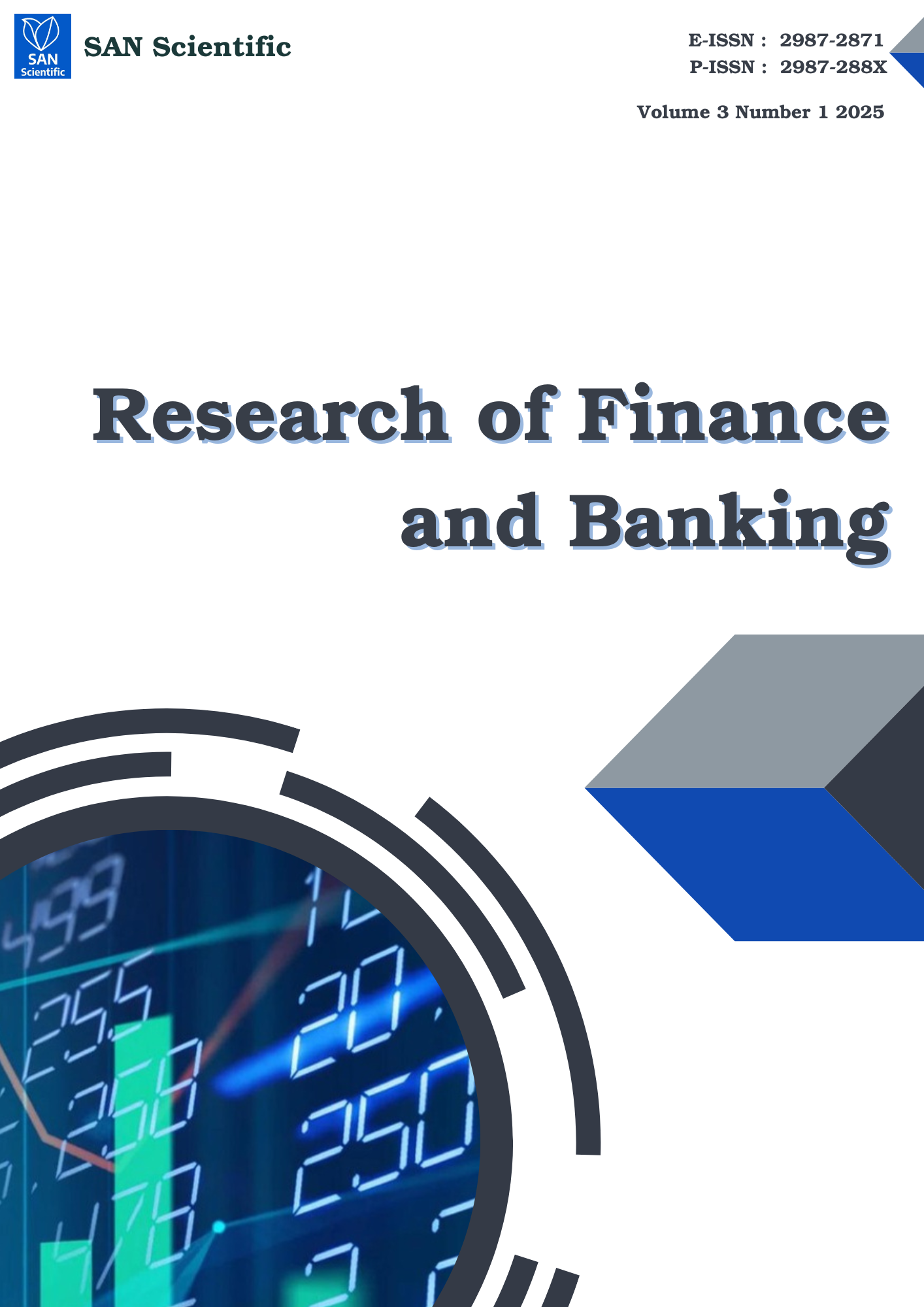Growth vs Value: A GARCH-APT Approach to Analyzing IDX Market Indices
DOI:
https://doi.org/10.58777/rfb.v3i1.426Keywords:
APT Model, IDX Growth30, IDX Value30, Market Timing, Value InvestingAbstract
Value and growth investing strategies are often compared in the investment world. This study analyzes the differences in performance of the IDX Value30 and IDX Growth30 indices as a representation of these strategies in Indonesia during the period from January 30, 2014, to September 30, 2022. Measurements were made using the Treynor Ratio, Information Ratio, and stock selection and market timing evaluations through the GARCH (1,1) model. In addition, the APT model was also used to test the influence of macroeconomic factors, such as inflation, IDR/USD exchange rate, and 5-year Government Bond Yield. The comparison of Treynor and Information Ratio was tested using the Mann-Whitney and independent sample t-test. The results show that both indices have positive performance ratios but are not significantly different. Both do not show stock selection capabilities, but IDX Value30 has market timing capabilities. The IDR/USD exchange rate has a negative effect, and the 5-year Government Bond Yield has a positive effect on IDX Value30, while there are no significant macroeconomic factors on IDX Growth30. This research provides a new contribution through a comprehensive analysis of IDX Value30 and IDX Growth30, which can be used as a reference for investment strategies in the Indonesian capital market.
References
Ahmed, I., & Khan, N. (2019). Who Is the Sharp Manager? A First Comprehensive Sectorial Wise Analysis of Mutual Fund Industry of Pakistan. J. of Multidisciplinary and Current Research, 7(2), 11–15.
Alfonso Perez, G. (2017). Value investing in the stock market of Thailand. International Journal of Financial Studies, 5(4). https://doi.org/10.3390/ijfs5040030
Alfonso Perez, G. G. (2018). Value investing and size effect in the South Korean stock market. International Journal of Financial Studies, 6(1). https://doi.org/10.3390/ijfs6010031
Amalia, D., & Sihombing, P. (2019). Analisis Kemampuan Stock Selection dan Market Timing Pada Reksa Dana Saham Di Indonesia Periode Januari 2008-Juli 2013. Journal of Capital Market and Banking, 2(2), 1–11.
Andersson, M., Krylova, E., & Vähämaa, S. (2008). Why does the correlation between stock and bond returns vary over time? Applied Financial Economics, 18(2), 139–151. https://doi.org/10.1080/09603100601057854
Antono, Z. M., Jaharadak, A. A., & Khatibi, A. A. (2019). Analysis of factors affecting stock prices in mining sector: Evidence from Indonesia Stock Exchange. Management Science Letters, 9(10), 1701–1710. https://doi.org/10.5267/j.msl.2019.5.018
Arnott, R. D., Harvey, C. R., Kalesnik, V., & Linnainmaa, J. T. (2021). Reports of Value’s Death May Be Greatly Exaggerated. Financial Analysts Journal, 77(1), 44–67. https://doi.org/10.1080/0015198X.2020.1842704
Asness, C., Frazzini, A., Israel, R., & Moskowitz, T. (2018). Fact, fiction, and value investing. Journal of Portfolio Management, 42(1), 34–52. https://doi.org/10.3905/jpm.2015.42.1.034
Assagaf, A., Murwaningsari, E., Gunawan, J., & Mayangsari, S. (2019). The Effect of Macro Economic Variables on Stock Return of Companies That Listed in Stock Exchange: Empirical Evidence from Indonesia. International Journal of Business and Management, 14(8), 108. https://doi.org/10.5539/ijbm.v14n8p108
Athanassakos, G. (2019). Value vs . Glamour Stock Returns and the Value Premium : The Canadian Experience 1985-2002. Canadian Journal of Administrative Sciences, 1–26.
Białkowski, J., Bohl, M. T., Kaufmann, P., & Wisniewski, T. P. (2013). Do mutual fund managers exploit the Ramadan anomaly? Evidence from Turkey. Emerging Markets Review, 15, 211-232.
Bird, R., & Casavecchia, L. (2007). Sentiment and financial health indicators for value and growth stocks: The European experience. European Journal of Finance, 13(8), 769–793. https://doi.org/10.1080/13518470701705777
Bodie, Z., Kane, A., Marcus, A.J. (2018). Essentials of Investments. 7th Edition, NY, United States. McGraw Hill, New York.
Brown, S., Ghon Rhee, S., & Zhang, L. (2017). The return to value in Asian stock markets. Emerging Markets Review, 9(3), 194–205. https://doi.org/10.1016/j.ememar.2008.05.002
Cadamuro, L. (2023). TCER Working Paper Series Value Premium in Japanese Market : Statistical ( Re ) appraisal. March.
Chan, L. K. C., & Lakonishok, J. (2024). Value and growth investing: Review and update. Financial Analysts Journal, 60(1), 71–86. https://doi.org/10.2469/faj.v60.n1.2593
Christian, C., & Rustam, R. (2018). Comparison of Companies’ Stock Returns Between Consumer Sector and Construction Sector on the Indonesia Stock Exchange. Jurnal Ekonomi & Studi Pembangunan, 19(2), 152–156. https://doi.org/10.18196/jesp.19.2.5006
Dash Manoj Kumar & Lall Gouri Shankar. (2018). International journal of engineering sciences & research technology performance evaluation of energy-conscious building rating as a leed -a review. International Journal of Engineering Sciences & Research Technology, 5(4), 293–302.
Fama, E. F. (1981). Stock Returns, Real Activity, Inflation, and Money. American Economic Association Stock Returns The American Economic Review, 71(4), 545–565.
Gunawan, K. H., Sujana, I. K., & Suputra, I. D. G. D. (2017). Perbedaan Return-Sesuaian Risiko Antara Value Stock Dan Growth Stock Di Bursa Efek Indonesia. E-Jurnal Ekonomi Dan Bisnis Universitas Udayana, 6(3), 909–934.
Israel, R., Laursen, K., & Richardson, S. (2021). Is (systematic) value investing dead? Journal of Portfolio Management, 47(2), 38–62. https://doi.org/10.3905/JPM.2020.1.194
Kakebeeke, J. (2020). The underperformance of Value vs. Growth stocks explained. Vba JOURNAAL Nummer, 144(144), 2020–2034.
Khan, M. K. (2019). Impact of Exchange Rate on Stock Returns in Shenzhen Stock Exchange: Analysis Through ARDL Approach. International Journal of Economics and Management, 1(2), 15–26.
Kasmiati, M., & Santosa, P. W. (2019). The effect of earning information, cash flow components, financing decision, and Stock Return: Empirical Evidence on Indonesia stock exchange. Journal of Economics, Business & Accountancy Ventura, 22(2), 157–166. http://sci-hub.tw/10.14414/jebav.v22i2.1638
Lev, B., & Anup, S. (2022). Explaining the Recent Failure of Value Investing. Critical Finance Review, 11(2), 333–360. https://doi.org/10.1561/104.00000115
Lin, F. L., Yang, S. Y., Marsh, T., & Chen, Y. F. (2018). Stock and bond return relations and stock market uncertainty: Evidence from wavelet analysis. International Review of Economics and Finance, 55, 285–294. https://doi.org/10.1016/j.iref.2017.07.013
Lucas, N. A., Cardo Manurung, J., Manurung, A. H., & Usman, B. (2019). The analysis of market timing, exchange rate of us dollar, and inflation to equity fund performance during 2011-2017. Journal of Applied Finance & Banking, 9(5), 1792–6599.
Maharditya, M. A., Layyinaturrobaniyah, L., & Anwar, M. (2018). Implication of Macroeconomic Factors to Stock Returns of Indonesian Property and Real Estate Companies. Jurnal Dinamika Manajemen, 9(1), 100–113. https://doi.org/10.15294/jdm.v9i1.14656
Maloney, T., & Moskowitz, T. J. (2021). Value and interest rates: Are rates to blame for value’s torments? Journal of Portfolio Management, 47(6), 65–87. https://doi.org/10.3905/JPM.2021.1.236
Manurung, A. H., & Sihombing, P. (2023). The Impact of Stock Selection, Market Timing and Equity Fund Size on Equity Funds Performance during Covid-19. Journal of Economics, Finance and Management Studies, 06(04), 1577–1587. https://doi.org/10.47191/jefms/v6-i4-21
Miller, M., & Prondzinski, D. (2020). Value Style Investing Versus Growth Style Investing: Evidence from the 2002-2019 Business Cycle. Journal of Accounting and Finance, 20(1), 131–151. https://doi.org/10.33423/jaf.v20i1.2748
Nugraha, N. M., Herlambang, D., Nugraha, D. N., & Amalia, S. (2021). The Influence of Macroeconomic Factors on the Volatility of Composite Price Stock Index: A Study on the Indonesia Stock Exchange Impact of the Covid-19 Pandemic on Financial Reports on Financial Performance (Study on Hospitality, Restaurant, and Tourism Sub. January.
Penman, S., & Reggiani, F. (2018). Fundamentals of Value versus Growth Investing and an Explanation for the Value Trap. Financial Analysts Journal, 74(4), 103–119. https://doi.org/10.2469/faj.v74.n4.6
Perez, G. G. A. (2018). Value and size effects in the stock market of the Philippines. International Journal of Financial Research, 9(2), 191–202. https://doi.org/10.5430/ijfr.v9n2p191
Pettengill, G., & Chang, G. (2014). Choosing between value and growth in mutual fund investing. Financial Services Review, 23(4), 341.
Putra, A. R., & Robiyanto, R. (2019). The effect of commodity price changes and USD/IDR exchange rate on Indonesian mining companies’ stock return. Jurnal Keuangan Dan Perbankan, 23(1), 103–115. https://doi.org/10.26905/jkdp.v23i1.2084
Rabbani, M. F., & Muharam, H. (2017). ANALISIS VALUE STOCK DAN GROWTH STOCK DI BURSA EFEK INDONESIA SETELAH KRISIS GLOBAL 2008 Studi Kasus pada Perusahaan di Bursa Efek Indonesia periode 2002- 2015. 6(2004), 1–8.
Reilly, F.K., Brown, K.C. (2017). Investment Analysis and Portfolio Management. 10th Edition, United States. Thomson South-Western.
Robiyanto, R., Wahyudi, S., & Pangestuti, I. R. D. (2017). The volatility–variability hypotheses testing and hedging effectiveness of precious metals for the Indonesian and Malaysian capital markets. Gadjah Mada International Journal of Business, 19(2), 167–192. https://doi.org/10.22146/gamaijb.26260
Santosa, P. W., (2019). Does Exchange Rate Volatility cause Overreaction in the Capital Market? Evidence from Indonesia. International Journal of Finance and Accounting, 8(3), 80–87. https://doi.org/10.5923/j.ijfa.20190803.02
Santosa, P. W., Setianingrum, A., & Yusuf, C. (2022). Corporate governance and leverage on firm value : Evidence of Indonesian large firms. Jurnal Keuangan Dan Perbankan, 26(4), 862–873. https://doi.org/10.26905/jkdp.v26i4.7764
Schiessl, C. (2024). Value stocks beat growth stocks : an empirical analysis for the German stock market.
Shradhanjali, P. D., & Ananya, M. (2018). Value {Vs} growth stocks: evidence from {Indian} stock market. Social Sciences, 2018, 6.
Sihombing, P., & Putra, W. S. (2024). Best Value Investing Strategy: Analysis of Graham, Greenblatt, and Piotroski Methods for Smart Investment Decisions. Research of Finance and Banking, 2(2), 97–108. https://doi.org/10.58777/rfb.v2i2.311
Sivilianto, H., & Endri, E. (2019). Determinants of external and internal stock price of coal mining subsector companies period 2005-2017. Scholars Bulletin, 9771, 162–168. https://doi.org/10.21276/sb.2019.5.4.5
Sofyani, N. W., Wahyudi, S., & Manajemen, J. (2019). Analisis Pengaruh Variabel Makro Ekonomi Global Dan Makro Ekonomi Domestik Terhadap Indeks Harga Saham Sektor Properti Dan Real Estate Dengan Metode Garch. Diponegoro Journal of Management, 5(1), 1–14.
Subing, H. J. T., & Apriansyah, P. M. (2024). The Affect of Firm Size, Debt Policy, Profitability on Stock Returns: Moderating Role Dividend Policy. Research of Finance and Banking, 2(2), 73–86. https://doi.org/10.58777/rfb.v2i2.278
Trinh, Q. T., Nguyen, A. P., Nguyen, H. A., & Ngo, P. T. (2020). Determinants of Vietnam government bond yield volatility: A GARCH approach. Journal of Asian Finance, Economics and Business, 7(7), 15–25. https://doi.org/10.13106/jafeb.2020.vol7.no7.015
Usman, B., Chandra, F. D., & Syofyan, S. (2021). Determinant of Indonesian Government Bond ‘Yield’ in Domestic Primary Market. Media Ekonomi, 28(2), 167–184. https://doi.org/10.25105/me.v28i2.9016
Wardani, S. S. (2021). Analisis Perilaku Herding Pada Saham Lq- Indonesia. Jurnal Ilmiah FEB, 9(2), 3–22.
Weng, J., & Butler, I. (2022). Value vs. Growth investing: Value returns with a vengeance. J.P Morgan Asset Management, 1–10.
Yana, M. D., Riwajanti, N. I., & Setiati, F. (2017). Analisis Securities Selection Skill dan Market Timing Ability Pada Kinerja Reksadana Syariah Campuran Di Bursa Efek Indonesia. PdfJournal of Research and Applications: Accounting and Management, 2(3), 215. https://doi.org/10.18382/jraam.v2i3.188
Zimmermann, H., & Zogg-Wetter, C. (2020). On Detecting Selection and Timing Ability: The Case of Stock Market Indexes. Financial Analysts Journal, 48(1), 80–83. https://doi.org/10.2469/faj.v48.n1.80
Downloads
Published
How to Cite
Issue
Section
Copyright (c) 2025 Pardomuan Sihombing, Iwan Triadji

This work is licensed under a CC Attribution-ShareAlike 4.0
 Views: 95
|
Views: 95
|
 Downloaded: 84
Downloaded: 84










